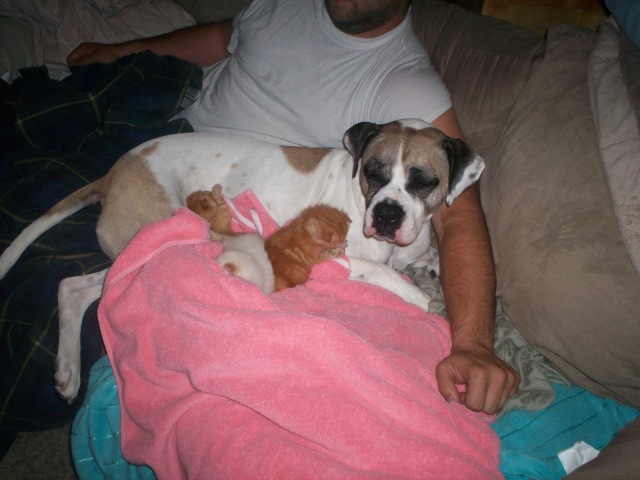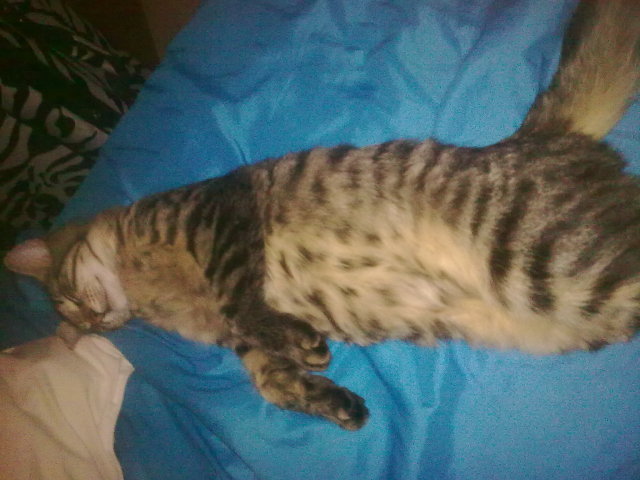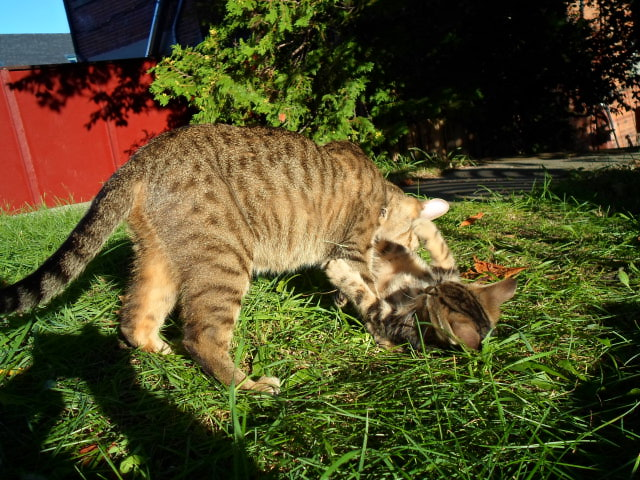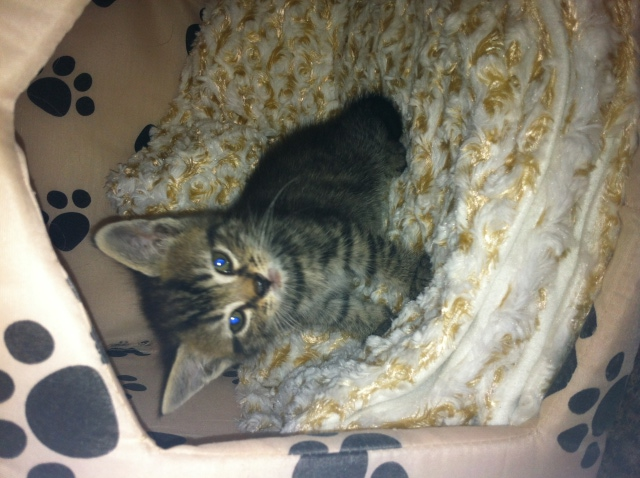QuestionQUESTION: I am taking in two rescue kittens of 13 weeks in two days, they will be introduced to my cat (female) of 7 years. From the foster family I have heard that they are tiny, about the size of a 5 week old kitten (360 grams), and one is tailless. They appear to be in good health, but need alot of human physical contact, and this makes me weary how to introduce them to the cat already in my home. Normally I would have kept them separate for a few days, but given the kittens physical need I feel it would be cruel to leave them alone, and closing my older cat in is not a good option. Is there in your opinion another way to introduce them?
The kittens are probably Manx, the litter was four kittens, one died at four and one at ten weeks. The kittens are too small to be given their shots, but have been inspected several times by a vet, who says they are of good health, however does not provide any information regarding why they are so tiny. Today the vet saw them and the only thing he could remark on whas that they where slightly dehydrated, and gave them iv for a bit, which they did not like at all. They eat solid and get extra formula, but they do not grow much.
Is there anything I can do to give them the human contact he needs while still introducing them in a good way? Is the small size in any way to do with the breed, or is this a really bad sign? What can I do to keep them alive and get them to good health?
Any advice you could give would be much appreciated!
Kind regards,
ANSWER: Hi Elisabet,
I would be concerned about the small size of the kittens. It should not have to do with the breed. In all but one of the cases where my foster kittens have had stunted growth, there has been a serious underlying cause. For this reason, I would not allow your current cat to have direct contact with the kittens until they are clearly growing and developing normally. I would recommend keeping the kittens in a crate in your main living area, if possible. This way, they will have some general contact with you most of the time, but they will be unable to interact directly with your cat.
If you haven't had the kittens tested for the feline leukemia and AIDS viruses, I would recommend doing so. These are two viruses that can cause stunted growth. They are ultimately fatal. If they come back positive for leukemia, the kittens should never have contact with other cats that are negative. I would recommend complete isolation (although chances are minimal, it's possible the disease could be passed through nasal secretions, so if the kittens sneeze directly on your cat through the crate, she may become infected). You may retest in three to six months to see if they become negative, since some cats can fight off the virus. If, after this time, they are still positive, this means they are permanently positive.
If they test positive for AIDS, I recommend retesting in three months, as well. Most young kittens who test positive do not actually have the disease but only test positive because their mother passed antibodies to them in her milk. If they are still positive at 6 months, they will probably remain positive. However, this disease is not easily passed in friendly households - it's only passed through bite wounds.
Also, if the kittens have not been dewormed, I would suggest calling the vet and asking for a dewormer. Sometimes a severe worm infection can prevent a kitten from growing properly.
If the kittens develop healthily under your care and it comes time to introduce them to your cat, she should have grown rather used to them while in the crate. When the kittens first come to your home, I would recommend covering the crate on all sides but one with a sheet. After a couple of days, uncover another side. Continue like this until the crate is uncovered. Your cat's curiosity will help get her acquainted with the kittens. When it's time for the kittens to come out of the crate, you should have few problems. If your cat does become upset, end the visit and try again later. You may want to see if they'll eat at opposite ends of the same room, and move the bowls closer each day until they're eating just a few feet apart. This may give them something positive to associate with one another.
Good luck!
Jessica
---------- FOLLOW-UP ----------
QUESTION: Hi Jessica,
Thank you so much for taking the time to help! The kittens have been checked for both FeLV and FIV, and have been dewormed, and still no answer to why they are so tiny has been found. The vets they've seen has no clue what it could be, and I am equally dumbfounded. Could there be something internally that makes them not absorb nutrition? They are being fed formula and solids, and get belly rubbed still. They do seem perfectly happy and are quite active.
You say that in all cases except one this has ended badly in your experience, is it your belief they will not survive (given the size of them i mean)
The kittens have had contact with other cats and dogs as well in their temporary home (since birth) and none of the other animals have taken ill.
Thanks for the feeding suggestion and the crate idea, it sounds like a very good idea, I will be using them!
AnswerIn most of my cases, the kittens turned out to have feline leukemia or a condition called FIP. FIP could be a concern for these little ones. This is a condition that is caused by a virus called corona. The corona viruses are generally pretty harmless and cause passing diarrhea. But one strain, and only in a small percentage of cats, can mutate and become deadly. Instead of staying in the intestinal tract and being eliminated by the immune system within a few weeks, it mutates and moves into the abdomen. Here, it becomes what's known as Feline Infectious Peritonitis (FIP).
FIP can take two forms - wet and dry. With the wet form, it causes fluid build up in the belly area. With the dry form, it can cause neurological problems, unexplained fever and organ failure among other symptoms. In both cases, stunted growth in kittens is seen before these symptoms develop in the end stages. The wet form tends to develop when cats have a very weak immune system, and the dry form develops if cats mount a partial response to the initial infection.
The propensity to develop FIP seems to run in families. While most cats are resistant to the mutation, kittens are most likely to develop it, and if one kitten comes down with it, then genetically, its siblings are more likely than other kittens to get it.
Unfortunately, FIP is fatal. Also unfortunately, there is no conclusive test. You can have an antibody test run on the kittens, but this will only determine if the kittens have been exposed to corona viruses in general. It will not determine if the kittens were exposed to the strain that mutates into FIP. It will also not determine if the kittens are those of the small percentage where the virus DID mutate into FIP. However, if the antibody count comes back extremely high, this might indicate that the kittens could have the condition. Generally, the kittens will need to have a high antibody count (called a titer) as well as many symptoms of the disease in order to be presumed positive.
It could also be possible that the kittens have some internal deformities stunting their growth, since they also have outward deformities (a missing tail in one case). Manx cats don't generally have anything wrong, but if you're unsure that there are purebred Manxes in these kittens' lineage, then the taillessness might be considered a spontaneous mutation, and cats with mutations are more likely to have mutations we can't see. One deformity that can cause stunted growth is a liver shunt. This is when a major blood vessel bypasses the liver. Nutrients are normally carried in blood vessels to the liver, where they are stored or utilized to supply the body with the nutrition it needs to grow. In animals with liver shunts, these nutrients are lost, and toxins may build in the bloodstream. Because the kitten is not being supplied with nutrients, it is not able to grow properly. Some liver shunts can be repaired rather easily. Some are more complicated.
But some kittens simply have a very difficult start to life, and malnutrition early on can lead to very stunted growth. These kittens typically catch up to normal size pretty quickly once their nutrition has been corrected. At times, they will remain on the small side. The most important part is that they have a healthy body condition - well muscled, shiny coat and bright eyes. If the kittens are energetic, have healthy appetites and their body condition is normal, then I would suspect they are probably healthy. Kittens with FIP are usually bony and have an "open coat" (the coat appears greasy and separates into parts over the spine).
Hope that helps!

 cat vitamins; valerian feline;; NuVet health pets; wholistic Feline;
QuestionHi, I have a mostly indoor cat - sh
cat vitamins; valerian feline;; NuVet health pets; wholistic Feline;
QuestionHi, I have a mostly indoor cat - sh
 how long do I need to bottle feed?
Question
3 weeks old with their
4 weeks ago I was ridin
how long do I need to bottle feed?
Question
3 weeks old with their
4 weeks ago I was ridin
 cat in labour
Questionxena last night
QUESTION: Hi!
I have a
cat in labour
Questionxena last night
QUESTION: Hi!
I have a
 Cat Breed Identification?
Question
Playtime Pretty Girl
Hi there. &n
Cat Breed Identification?
Question
Playtime Pretty Girl
Hi there. &n
 Bengal kitten?
Question
Pic Picture
Hello, I was wonderi
Bengal kitten?
Question
Pic Picture
Hello, I was wonderi